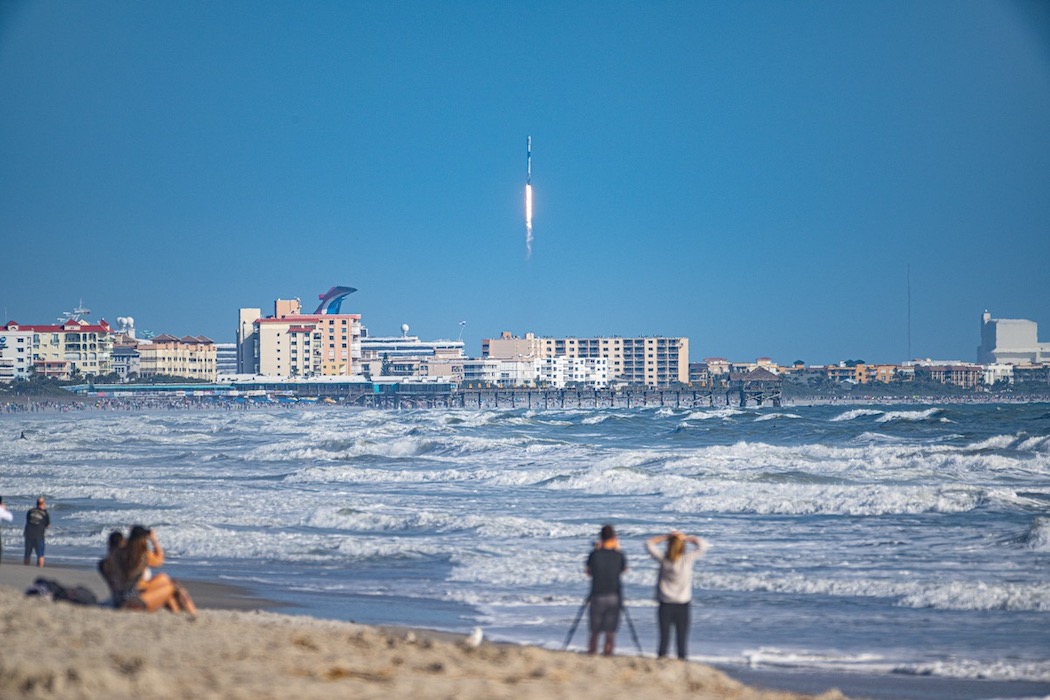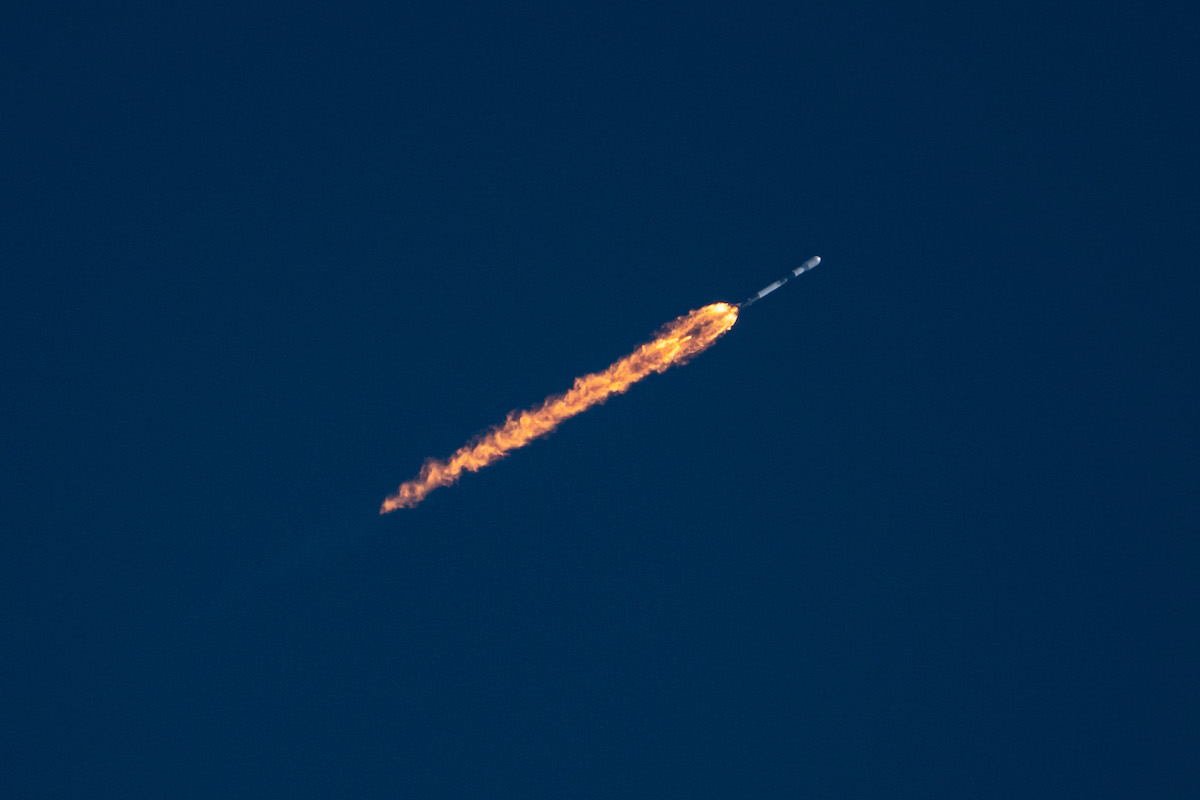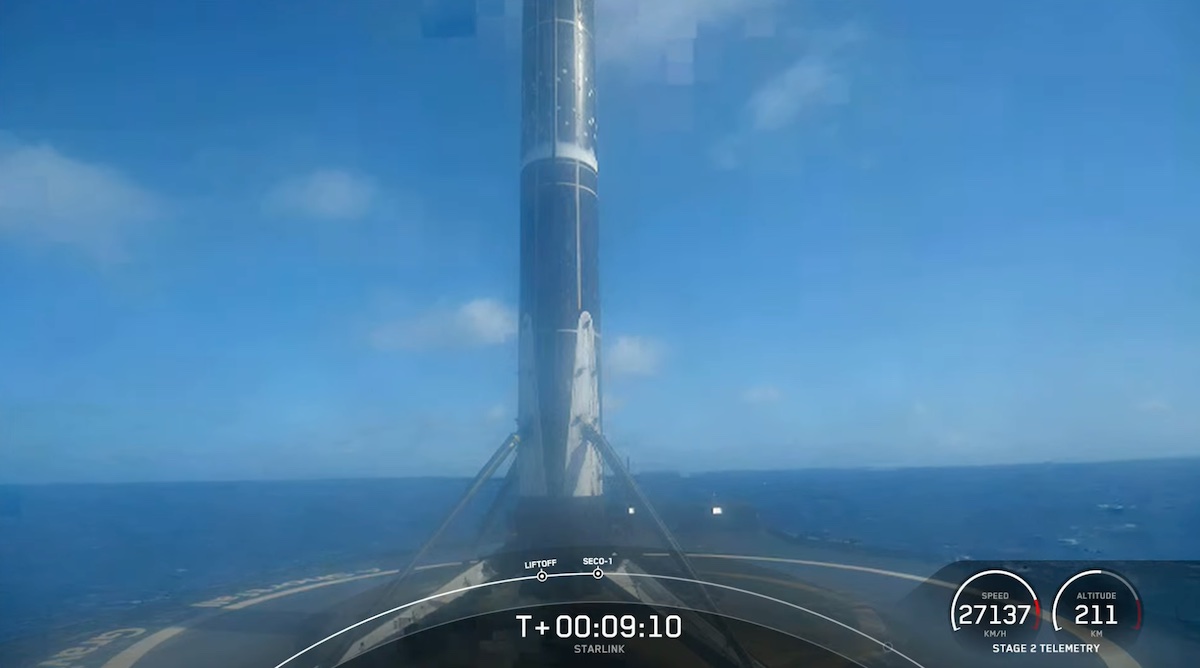
SpaceX launched a Falcon 9 rocket Monday from Cape Canaveral with 46 more satellites for the company’s Starlink broadband network, deploying the payloads in a higher orbit than recent flights after atmospheric drag brought down nearly 40 Starlink spacecraft from the previous mission.
The launch Monday was the first of three SpaceX launches scheduled over the next 10 days for the Starlink internet network, continuing the company’s pace of averaging around one launch per week since the start of the year.
A 229-foot-tall (70-meter) Falcon 9 rocket ignited nine Merlin 1D engines at 9:44:20 a.m. EST (1444:20 GMT) and rumbled away from Space Launch Complex 40 at Cape Canaveral Space Force Station, kicking off SpaceX’s seventh mission of 2022.
The nine kerosene-fueled engines accelerated the rocket on a trajectory southeast from Cape Canaveral with 1.7 million pounds of thrust. Within a minute, the Falcon 9 had surpassed the speed of sound as it rocketed through a crystal clear sky.
The first stage’s nine engines shut down two-and-a-half minutes into the flight. Moments later, the booster jettisoned from the Falcon 9’s second stage, beginning maneuvers to return to Earth for a landing on SpaceX’s drone ship parked near the Bahamas around 400 miles (650 kilometers) downrange from Florida’s Space Coast.
The second stage, meanwhile, lit its single Merlin engine for a six-minute burn to reach a parking orbit. Early in the second stage burn, the rocket shed its two-piece payload shroud, which also returned to Earth under parachutes for recovery from the Atlantic Ocean.
The Falcon 9’s booster stage nailed its landing on the drone ship, settling onto the football field-size deck of the landing platform nearly nine minutes after launch. The landing punctuated the 11th trip to space for this booster, tail number B1058 in SpaceX’s fleet.
The drone ship will will return the booster stage to Florida for refurbishment and preparations for a future mission. The two fairing halves, each launched for a fifth time Monday, were also expected to return by ship to Cape Canaveral.

The Falcon 9’s second stage switched off its Merlin engine after reaching a preliminary transfer orbit. A brief restart of the Merlin upper stage engine at T+plus 56 minutes placed the satellites into a nearly circular orbit more than 200 miles (320 kilometers) above Earth.
That set the stage for deployment of the 46 flat-packed Starlink satellites at 10:47 a.m. EST (1547 GMT). The separation occurred while the rocket was flying out of range of ground stations, but SpaceX teams confirmed the deployment once the Falcon 9 passed over a tracking site in Alaska.
The satellites, each about a quarter-ton in mass, were expected to unfurl their solar panels and turn on krypton-fueled ion thrusters to begin climbing to their operational altitude of 335 miles (540 kilometers).
Monday’s launch placed the 46 new Starlink satellites into an orbit with a track tilted 53.2 degrees to the equator.
SpaceX started launching Starlink satellites on paths to the southeast from Florida last month. The company said it wil launch more Starlink missions to the southeast in the winter months to take advantage of better odds of good weather in the first stage’s landing zone.
Previous Starlink missions launched to the northeast, with booster landings in the Atlantic Ocean east of South Carolina. Launching toward the southeast requires the Falcon 9 rocket to steer around the Bahamas, reducing the number of current generation Starlink satellites the rocket can carry from 52 to 49.
SpaceX’s recent Starlink missions used a single burn by the second stage engine, while Monday’s flight utilized two burns. This change cuts the number of Starlink satellites carried by the Falcon 9 rocket from 49 to 46.
The previous Starlink mission, which launched Feb. 3, placed 49 satellites into a more oval-shaped, or elliptical, orbit with a perigee, or low point, about 130 miles (210 kilometers) above Earth.
But a geomagnetic storm triggered by a solar flare led to the destruction of at least 38 of those satellites. The solar flare sent a burst of radiation into the solar system, causing Earth’s atmosphere to warm and swell, leading to more atmospheric drag working against satellites in low Earth orbit.
The 49 Starlink satellites that launched Feb. 3 were especially at risk from the geomagnetic storm because they were flying so close to Earth, at about half the altitude of the International Space Station.
SpaceX ground controllers commanded the new Starlink satellites into safe mode, orienting them to fly edge-on against the atmosphere to minimize drag. But the drag still slowed the satellites’ velocity enough to re-enter the atmosphere, where they were expected to burn up before impacting Earth’s surface.

SpaceX typically deploys Starlink satellites into low orbits so they can quickly fall back into the atmosphere if they fail, ensuring they don’t become space junk. Once SpaceX confirms a satellite is healthy, teams send commands to begin orbit-raising into the operational Starlink network using ion engines.
Officials expected up to 40 of the satellites launched Feb. 3 to re-enter the atmosphere after the geomagnetic storm. SpaceX ultimately lost 38 of the 49 new spacecraft, with the remaining 11 now raising their orbits.
There’s also another benefit to launching into a low orbit. A Falcon 9 rocket can haul more Starlink spacecraft on a single mission if it targets a lower altitude.
With Monday’s flight, SpaceX has launched 2,137 Starlink spacecraft since 2018, including prototypes. More than 200 of the satellites have fallen out of orbit after failure or decommissioning, according to a tabulation maintained by Jonathan McDowell, an astrophysicist and expert tracker of spaceflight activity.
McDowell’s chart shows more than 1,500 Starlink satellites are currently operational and providing internet service. SpaceX does not regularly release details about the number of satellites in its active constellation.
SpaceX is in the midst of deploying of around 4,400 Starlink satellites in five orbital “shells” at slightly different altitudes and at different inclinations, or angles to the equator, enough to provide global internet connectivity. The company’s recent launches, including Monday’s mission, have targeted an orbital shell at an inclination of 53.2 degrees and an altitude of 335 miles (540 kilometers).
The company has plans to eventually launch as many as 42,000 Starlink satellites to expand internet coverage, an ambitious goal that could be aided by the start of missions using SpaceX’s next-generation heavy-lift Starship rocket.
SpaceX has two more Starlink missions slated to launch in the next 10 days, with other Falcon 9 rockets due to take off from California and Florida on Feb. 25 and March 3.

The launch Feb. 25 will lift off from Vandenberg Space Force Base, northwest of Los Angeles. That flight is expected to include a landing of the Falcon 9’s first stage on a drone ship in the Pacific Ocean.
SpaceX will follow that with a mission March 3 launching from pad 39A at NASA’s Kennedy Space Center, again hauling a stack of Starlink internet satellites to orbit.
Additional Starlink missions are on tap later in March.
SpaceX’s next mission not dedicated to the Starlink program is scheduled for March 30, when a Falcon 9 rocket will launch a Crew Dragon spacecraft into orbit from Kennedy Space Center with a crew of four commercial astronauts and space tourists heading for the International Space Station.
Email the author.
Follow Stephen Clark on Twitter: @StephenClark1.
